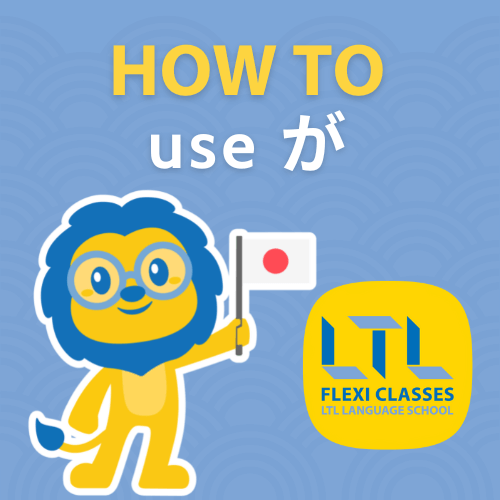N5 Grammar | How to Use が, the Subject Particle
Welcome to another particle lesson! This time, we will focus on how to use が, the Japanese subject particle.
The Japanese language, like the Korean language, uses several particles to mark a noun, verb, adjective, or sentence.
We already mentioned the object particle as well as the possessive particle in previous lessons, and will explain about the Japanese subject particle today.
Let’s go!
How to use が | Basic Structure
How to use が | Differences Between は and が
How to use が | FAQ’s

How to Use が | Basic Structure
The subject of a sentence is what “does” the verb, or “is” the adjective or noun.
The subject is followed by particle が (ga).
| Kanji | Hiragana | Romaji | English |
|---|---|---|---|
| 車がほしい | くるまがほしい | kuruma ga hoshii | I want a car |
| 彼が読む | かれがよむ | kare ga yomu | He reads |
But what about topic particle marker は? Like in this sentence:
| 私はジョンです | わたしはじょんです | watashi wa jon desu | I am John |
There is no subject marked with が in this sentence.
But what is a sentence without a subject?
Many times in the Japanese language, information can be easily inferred through context.
Even though the subject is not stated in the sentence, it is implied that the subject and the topic are the same.
How to Use が | Differences Between は and が
Differences between は and が can be tricky, as we can also say:
| 私がジョンです | わたしがじょんです | watashi ga jon desu | I am John |
instead of:
| 私はジョンです | わたしはじょんです | watashi wa jon desu | I am John |
The difference between these two sentences, and understanding how to use the subject particle が, comes down to understanding the difference between は and が.
In the sentence 私がジョンです, there is a nuance that speaker is emphasizing the word 私 (I), as in, “I am John (someone else is not John)”. This could be in response to the question, “who is John?”, or, “is he John?”
- In this way, the subject particle が can emphasize the thing that comes before it.
- は, on the other hand, can give more emphasis on what comes after it.
We can only use が when the subject is something uncertain, like なにか (nanika, something), or だ れか(dareka, someone).
How to Use が | With clauses
We also need to pay attention to the use of particle が in clauses. It can indicate the subject of a particular clause, but not the subject of the sentence as a whole.
| 私は家が揺れるのを感じた | わたしはいえがゆれ るのをかんじた | watashi wa ie ga yureru no wo kanjita | I felt the house shake |
If we break the sentence down into its parts, it is easier to see what the subject, object, and verb of the sentence are.
| 私は | 家が揺れるのを | 感じた |
| I (topic) | the house shake (object) | felt (verb) |
Even though particle ga is after 家 (ie, house), the subject of the sentence is not the house.
It is the subject of the clause. The house is not the thing that “did the verb” of the sentence, which is “felt”. It was “I” who did the feeling. So, “I” is actually the subject of the sentence.
So in the previous example, the topic and the subject were the same.
How to Use が | Omitting the subject
Sometimes, the subject of the sentence is omitted entirely because it can be inferred from the context.
If you just felt the house shake from an earth quake, you could turn to your friend and say:
家(いえ)が揺(ゆ)れるのを感(かん)じた without starting with 私(わたし)は, and it would be obvious from context you were talking about yourself.
In this next example, the subject has been omitted as well.
| 今日はスーパーに行きます | きょうはすーぱーに いきます | kyou wa suupaa ni ikimasu | Today I will go to the supermarket |
In this sentence, there is nothing marked with が, and there is something marked with は. But the topic of the sentence is not the subject of the sentence.
Today is not what is going to the supermarket. In this case, it is likely again to be “I”, and there isn’t much need to specify that directly.
If one did choose to say, 今日は私がスーパーに行きます it would probably be to emphasize the fact that today, the speaker is the one going to the supermarket.
It is like saying, “On another day, someone else might be going to the supermarket. But, as for today, I am going to the supermarket.”
How to Use が | Exceptions
There are times when the difference between using は and が is only a matter of nuance. But there are also times when only one or the other is used.
We can only use が when the subject is something uncertain, like なにか (nanika, something), or だ れか(dareka, someone).
Something that is unknown cannot be the topic of a sentence:
| だれかがきています | dareka ga kiteimasu | Someone is coming. |
We can only use は when the sentence is something ending in a negatively conjugated verb.
| コーヒーは飲みません | kōhī wa nomimasen | I don’t drink coffee. |
Japanese learners will spend a lot of time trying to understand the differences between は and が and how to use the subject particle properly.
The best ways to do this are:
- 1) By trial and error, and being corrected by native speakers
- 2) By listening and reading to native speech and text, and paying attention to the ways they use these particles.

Are you a Flexi Classes student already?
Learn more about the Japanese Subject Marker in the following Flexi lessons:
This Is The Key (A1, Chapter 1)
Tom Is At School (A1, Chapter 3)
Not a Flexi Student yet?
Et voilà! A short and simple lesson on how to use が to help you get more and more familiar with Japanese particles.
Make sure to check our other N5 lessons:
- How to learn Katakana
- How to learn Hiragana
- Japanese Sentence Structure
And why not start learning Japanese with a certified teachers and other Japanese language enthusiast?
You can learn with up to 4 classmates on Flexi Classes, and even choose WHAT and WHEN to study!

HOW TO USE が || FAQS
What is が?
が is a subject particle of the Japanese language.
How to use が?
The subject particle が is added after the subject in a sentence.
Any sentence examples with が?
車がほしい | I want a car.
彼が読む | He reads.
だれかがきています | Someone is coming.
What is the Japanese basic sentence structure?
The most basic structure of the Japanese language is:
Subject + は + Object + です.
Check out all of them in our Sentence Structures lesson.
Any other particles I should know about?
Japanese has several important particles to learn about:
– The object particle を
– The subject particle が
– The possessive particle の
– Locations particles で, に, and へ
You’ll see more as you move forward in your language learning.
Where to learn Japanese?
You can learn Japanese with LTL, both online and offline.
Study 24/7 on Flexi Classes, our online teaching platform where you can choose what, when and how to learn. We have a 7 Day Free Trial!
We now also offer Japanese courses in person, in Tokyo! Choose between group or individual classes, and live with a homestay family while you’re in Japan.








